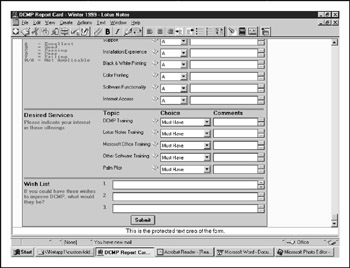THE PROJECT PLANNING TEAM
| | ||
| | ||
| | ||
Once an executive sponsor has been identified and management has accepted the feasibility committee's financial analysis of implementing an enterprise deployment of Citrix Access Suite, a planning team can be assembled .
The project planning team will be primarily composed of IT staff, including hands-on technical people. It should also include some members from the feasibility committee and possibly representatives from multiple departments or divisions. This will help ensure that the organization's enterprise goals are met with this enterprise deployment. Each member's role and expected contributions should be defined. Accountability should be established.
Consultants
Since Citrix Access Suite rides on top of Windows server technology many organizations are inclined to plan the entire process internally and use only existing staff. This is probably not an optimal utilization of resources. We recommend seeking out Citrix specialists who have designed and implemented multiple large-scale on-demand access migrations. The experience they bring to the table should pay for their fees many times over.
Depending upon the size of the project and organization, it may also be worthwhile to consider using a change management consultant who is very experienced in helping implement organization-wide change. As with all consultants, we recommend requesting and checking references.
The Project Definition Document
The first task of the planning committee is to prepare a document defining project goals, scope, roles, and risks along with success criteria and milestones. This will be a living document that will guide the planning team through the infrastructure assessment, design, and implementation stages. As expectations, requirements, and conditions change, the planning definition document will serve as a touchstone for keeping the project on track.
Project Goals
While saving money is likely to be an important objective, the strategic advantages and other benefits described in Chapter 1 may be even more important considerations. Clearly defined project goals serve as a benchmark as the on-demand access project rolls out.
Project Scope
The preliminary work done by the feasibility committee combined with management's reaction to the financial analysis enable the planning committee to identify the parameters of the Citrix project. In particular, the committee must select the applications to be run via Citrix along with expectations for stability and for upgrades during the implementation process. Adding a new application, for example, requires extensive testing as well as the creation of a new server image. What's known as scope creep is inevitable, and guidelines need to be established for an approval process when requests for additional applications or features are made. Allowances must also be made for delays caused by these changes.
Project Roles
Keeping the project's executive sponsor closely informed of progress will help garner upper management support when needed. The project also requires both an IT owner and a high-level business owner who can intercede to work through any problems that may arise. A project manager needs to be assigned along with a backup project manager who can make decisions in the event the project manager is unavailable. Outlining escalation procedures for contacting the appropriate decision maker in the event that the project manager is unable or unwilling to solve a problem helps to keep things on track. If the rollout is large enough, both a quality assurance person and a training coordinator should be assigned to the project as well.
Project Risks
Identifying risks such as scope creep, unavailability of resources, and lack of user acceptance helps the committee include strategies for reducing the risk of problems with the project. Contingency plans should also be included.
The Criteria for Success
Identifying the criteria by which the project will be judged a success enables the planning and implementation teams to better focus their energies. If user satisfaction is a requirement for success, for example, user surveys should be designed along with a mechanism for their distribution, collection, and tabulation. We recommend simple electronic forms allowing users to grade the Citrix project on items such as performance, functionality, and reliability. Figure 4-1 shows a sample of the Lotus Notes-based survey forms that ABM e-mailed to their users.

Figure 4-1: ABM's user survey form
Project Milestones
The infrastructure assessment and upgrade, design document, beta implementation, enterprise rollout, and administrator and user training are examples of project milestones.
Change Management
| |
Organizations are first and foremost social systems. Without people, there can be no organization . Organizations are hotly and intensely political.
Fred Nickols, Change Management Expert
| |
The analysis prepared by the feasibility committee regarding corporate culture and politics should be incorporated into a plan for successful organizational change. Potential implementation of new application standards, user perceptions of IT, reductions in IT staff and IT salaries, and other political considerations need to be addressed and solutions for them found. For instance, one of our customers created an organizational change plan that began with a meeting of the presidents of all the business units. By explaining the benefits of an on-demand enterprise, he turned the presidents into allies that helped smooth the process of organizational change. Preparing for organizational change is covered more thoroughly in Chapter 10.
EAN: 2147483647
Pages: 137